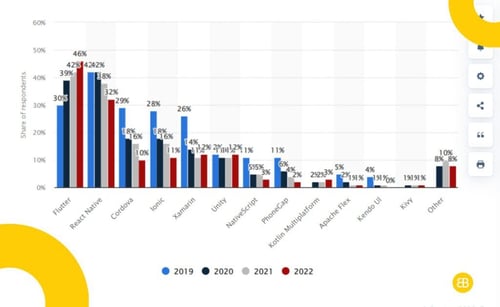Table of Contents
Truth be told, the tools and technologies you use in app development can make or break even the best ideas.
“Which programming languages and frameworks do we use?”
“Should we go for low-code platforms?”
“Is it more time-efficient to choose no-code platforms?”
“Do we outsource app development?”
There’s no correct answer — it all depends on factors such as your business requirements, target audience, time constraints, and budget.
But with so many options out there, it can be overwhelming to know what to choose, whether you have an in-house team or you’re working with an external agency.
In this article, we’ll uncover everything you need to know about Flutter app development, from features and benefits to how it can help you build a successful mobile application.
What Is Flutter?
Flutter is the Software Development Kit (SDK) created by Google and one of the most commonly used frameworks worldwide. Ever since its launch, Flutter has become a particularly popular choice for developers, being known for its high-performance, visually attractive iOS and Android apps.
In other words, Flutter enables developers to efficiently create various apps, like social media platforms, music players, banking apps, and much more. Some notable examples of Flutter applications are:
- Google Pay
- Tencent
- ByteDance
- Alibaba
- BMW
- Toyota
This is one of the many reasons why Flutter is one of the most popular cross-platform mobile frameworks, as it is used by 30% of software developers across the globe. Recent surveys show that more than 2 million developers have used Flutter to build mobile apps.
But why is Flutter so popular?

Source: Statista
Why Are Flutter Mobile Apps Popular?
Flutter mobile apps are popular due to their impressive performance and the time and cost savings that come with using a single codebase for both iOS and Android.
Additionally, Flutter apps are known for their smooth animations and customisable widgets which allow developers to create unique and visually appealing user interfaces faster and more efficiently.
Some of the reasons why Flutter apps are in high demand are:
- High performance
- Time and cost-efficient
- Easy to implement in large-scale businesses
- Flexible and scalable
- Hot reload function for instant changes
- Optimised for UI

How Does Flutter Work?
Flutter works by compiling its widgets, functions, and libraries into native code that can seamlessly run on platforms like iOS and Android. This means there’s no need to have separate development teams for each platform, saving you precious resources in the long run.
Another key advantage of Flutter is that it uses its widgets to create unique user interfaces, rather than relying on native components. Think of these widgets as UI building blocks that can be easily customised to meet your project requirements.
Moreover, Flutter supports various hardware and services to create complex mobile applications that accurately reflect your vision for the application. This includes access to features like the phone camera, GPS, network, and payment, cloud storage, and authentication services.
Cross-Platform Vs. Hybrid Vs. Native Mobile App Development
When it comes to mobile app development, businesses have three options: cross-platform, hybrid, or native development. Below, we’ll explore what each option means, the main differences, and common misconceptions:
Cross-Platform Apps
Cross-platform app development involves building one codebase that can run on different platforms. One of the many benefits of cross-platform development is that it can save time and money, as developers reuse the code to run on different devices. That means fewer hours of work, and fewer expenses, making it a valuable asset for both startups and small businesses as well as large enterprises.
Besides Flutter, one of the most widely used cross-platform development frameworks is React Native. Both frameworks offer the ability to create high-performance iOS and Android mobile applications. One of the advantages of using one over the other is that React Native uses JavaScript, regarded as the most popular programming language.
Native App Development
What makes native apps stand out is the fact they use programming languages specific to a platform. For example, Kotlin is used for Android apps, whereas Swift is used for iOS applications. Since they’re optimised for their respective platforms, native apps can offer enhanced performance and a more consistent user experience. However, native development can be more time-consuming and costly in terms of development but also testing, and maintenance.
Hybrid App Development
Hybrid apps rely on programming languages such as HTML, CSS, and JavaScript, and frameworks such as Apache Cordova to turn the web development script into a native container that can work on different platforms. Hybrid apps may have some drawbacks, such as reduced performance and limited functionality, compared to cross-platform and native applications.

Frequently Asked Questions
What programming language is used with Flutter?
Should my business use Flutter?
How long does it take to build a Flutter application?
Bottom Line
Ultimately, Flutter is one of the most popular cross-platform app development frameworks for a reason — it enables developers to build high-performing, feature-rich apps for multiple platforms, more easily than ever. It is a fantastic choice for businesses working with tight budgets and/or time constraints, as Flutter apps take an average of 3 months to develop.
While many use Flutter to create powerful cross-platform mobile applications, you need to take into account your project’s specific requirements. Try to understand your target audience, their preferred platforms (i.e., web, iOS, Android), and what features you’re looking to implement. Get in touch with the EB Pearls team and schedule your free discovery session to find out what works best for your project.

Akash, COO at EB Pearls, blends technical expertise with business acumen, driving the creation of successful products for clients.
Read more Articles by this Author
